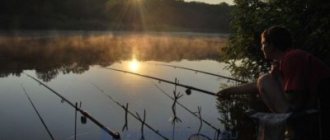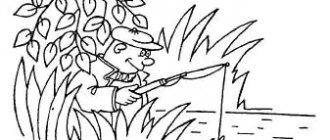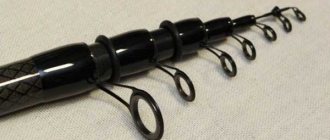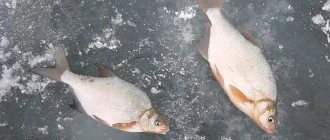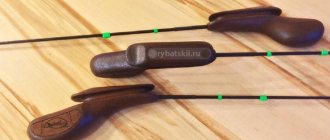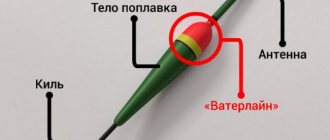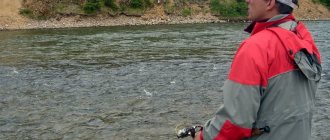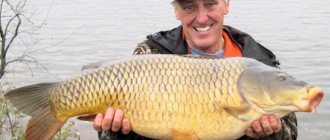Tench is a difficult trophy for an angler. It is not easy to find fish that lead such a sedentary and secretive lifestyle. His favorite habitats are large lakes and ponds with banks overgrown with reeds. You can also find it in the bays of rivers with weak currents. In order to catch a truly worthy specimen with a fishing rod, you need to study the habits of this fish very well. One of the most popular ways of catching tench is fishing with a float rod.
Let's look at how to catch tench with a float rod - in spring and summer. Let's look at how to properly make a float rig and how to make the best bait for tench.
Equipping a float rod for a line
Rod
The type of rod for catching tench can be any: fly rod, match rod, plug rod. You can use what you are used to. The rod length requirement is up to 6 meters. This length is optimal for fishing in the coastal zone; a longer length will be inconvenient when casting. The main purpose of the fishing rod is to allow you to accurately cast into windows of coastal vegetation. In addition, the rod should not only be strong enough and elastic, but also sensitive. Tench is a large fish, and its jerks are very strong. The elasticity of the fishing rod should increase from the middle to the end. This will allow you to make a soft hook and effectively resist the jerking of the fish.
Coil
The best option is an open coil. Its main advantages:
- The ability to cast accurately and far, even with a small float weight,
- Easy line shedding when fishing without a float.
Leash
The best solution would be to use monofilament or fluorocarbon leader with a load capacity of 1.2 - 2.5 kg, and a cross-section of 0.22 - 0.26 mm.
The leash is taken from a veined transparent mono fishing line. The section of the leash is selected to be thinner than that of the main line - 0.20 - 0.23 mm. The length of the leash should be at least 20 - 30 cm. Based on the living conditions of the fish, the use of colored fishing line has a good effect: brown for places with a lot of snags and flooded trees and green for areas covered with aquatic plants. A good way to give the fishing line a light brown color for fishing in bodies of water with standing water and a lot of vegetation is to use onion skins. We reserve 20 - 30 grams. husks, put in a jar, pour 100 - 120 g. water, boil for 5 - 10 minutes and immerse the fishing line completely in water. Leave for 3 – 4 hours. The result will be a rich shade, ideal for fishing in troubled waters.
Setting up the equipment
When fishing for tench, the best option for attaching a fishing line is running tackle. With this option, the line passes to the top of the rod with the help of rings, which significantly increases the casting range and makes maneuvering easier. Line passed through guides distributes the weight of the fish evenly across the entire rod, reducing the risk of breakage.
Floats should be selected depending on the fishing location: if fishing is along the shore, you need to use a sensitive float, for long casts you need a heavier float. A “goose feather” is usually used as a sensitive float, and spherical or conical varieties are used as a weighted float. The float is attached to the fishing line using nipple rubber or silicone rings.
A cut pellet is used as a weight. We fasten it in the standard way: insert the fishing line into the slot and firmly fix the pellet. Using a pellet allows you to adjust the casting depth.
The hook on the line is I-beam in diameter for the forehead and back of the head and rounded in the ring and fore-end. Please note: the forend should be slightly thicker than the forehead. The bending shape of the hook is straight. The extension of the beard should be average. Such characteristics of the hook will allow you to effectively hook the fish, capturing more tissue from the mouth, but at the same time not tearing the lips, facilitating the dehook. Optimal hooks for line No. 14 or 16 in accordance with the international classification.
Tackle

Rod
Tench fishing gear must meet certain requirements. This is, as a rule, a fishing rod, from 4 meters to 7 meters , and quite strong, since a line weighing 0.5 kg is capable of strong resistance. The tip of the rod should be soft, capable of bending 180 degrees. If the tip of the rod is stiff, you need to make sure that it does not bend too much when playing fish, otherwise it may break.
Coil
It is not necessary to equip a regular fly fishing rod with a reel, especially an inertia-free one, since it greatly weighs down the tackle. It is possible to use a small inertial reel only to store a supply of fishing line on it. It could even be a rod that does not have guide rings. Coils are not installed on such forms.
fishing line
Main
You can use monofilament as a fishing line, as well as a fluorocarbon leader. The thickness of the fishing line is selected depending on its quality and can have a diameter from 0.25 mm to 0.3 mm. A good result can be expected from a foreign-made fishing line, which has better line thickness and different loads, in contrast to domestic ones.
Leash
As a leash, you can use a piece of regular monofilament fishing line or fluorocarbon. The diameter of the leader line should be smaller, about 0.05 mm. At the same time, fluorocarbon fishing line has a lower breaking load, and this property should be taken into account when choosing a leash.
Best fishing time
In spring, tench fishing begins in May. In the earlier period, the fish bite inactively, especially if spring is late and the water does not warm up well. In May, before spawning, the bite usually becomes more active. The right landmark is the beginning of viburnum flowering. During this period, the most productive places for fishing will be:
- large driftwood,
- half-submerged trees,
- areas at the border of water and reed thickets.
Casting depth is up to half a meter.
The pre-spawning bite is the most active, so it is better to go for serious trophies in the spring. Biting activity is higher in the absence of wind. Activity time is from sunrise to ten o'clock in the morning. Then the biting may resume in the afternoon. Hunting for tench in the summer should begin from the same places where spring fishing took place.
The only adjustment is that the fish often stays in the shade, so casting into the gaps of the thickets of water lilies and water lilies is very effective. The boundaries of reed thickets are also a good place to search for tench. The best time for summer fishing is early morning and before sunset. In autumn, tench usually stay at shallow depths. The water becomes clear, and places of possible casting can be determined by small clouds of turbidity that appear at shallow depths and streams of air bubbles. Tench rarely change their habitat, so bites should be expected where there has already been a bite in spring and summer. The best time for fishing is a warm, calm morning. In windy weather the biting stops.
Float tackle for catching tench
The advantage of float gear for catching tench is explained by its habits and habitat. Since the tench stays near overgrown coastal areas, there is no point in throwing it far from the shore. Throwing bottom tackle into grass windows is very problematic, which cannot be said about float tackle.
Choosing a fishing line
Any monofilament carp line with a cross-section of 0.28 will do, for example ForMax Black Carp.
To catch tench, it is better to use fairly strong fishing lines, since the tench can create a sufficient load for it. Tench rarely reaches more than 2 kg in weight. Therefore, a fishing line with a cross-section of 0.2-0.30 should be quite enough. The universal thickness can be considered 0.28 mm. When choosing a fishing line, you need to maintain a balance between delicacy and strength. You can’t thicken the line too much, otherwise the tench can be spooked by very coarse tackle. But there is no need to make it too thin; the tench with all its jerks can wrap the grass around itself, increasing the load.
It is worth paying attention to the color of the fishing line. It is better to camouflage the fishing line by choosing a green or brown color to match the color of the grass or bottom. For a leash, the fishing line is taken a little thinner, one size smaller than the main one.
Float
Tench bites are very specific. Tench bite extremely carefully, especially in the summer. It’s not for nothing that it got its name; compared to other fish, tench bite extremely lazily, cautiously and seemingly reluctantly.
If other fish grab the bait and swim further, sinking or lifting the float, the tench can stand at the fishing point for a long time and not move from the spot, savoring the bait. During this time, he can taste the bait and spit it out, and the fisherman will not even notice the bite. Therefore, the equipment must be very delicate. This is necessary to see even the slightest movement of the nozzle. Such equipment can be used, since tench live in places where there is practically no current.
You can use floats from
1 to 3 grams .
Using large sizes, there is a chance that the tench will feel the resistance of the float and spit out the bait. The float must be properly loaded so that only the antenna sticks out of the water. You can use both sports floats and your grandfather’s old goose feather. You can try to fish further away from the shore. Then you cannot do without using a sliding float. Although this is not very convenient when fishing, especially in heavily overgrown places. For float fishing, the best shipping option is to use a subscription. This is a small lead pellet that lies on the bottom and does not affect the carrying capacity of the float. Using a padding makes the tackle even more delicate.
Hooks
It is better to use hooks No. 6 or 8 . Tench lives in reservoirs with a large number of other smaller fish. Therefore, to cut off the bites of this little thing, use a large size. Tench is caught using a bunch of worms. This rather large hook size will allow you to hold a voluminous bait. But if the size is large, it is better not to use hooks made of crushed wire. The thinner the better for the job. The tench can feel a hook made of thick wire while it tries, savoring the bait on the hook and this will scare it off.
Catching tench on a float, watch:
Bait for tench
As a basis for feeding tench, you can use ready-made commercial mixtures with the smell of worms. The main requirements are the presence of large fractions and a not too pronounced odor. To this base you need to add:
- Maggots (preferably red ones),
- Chopped earthworms (mandatory),
- Steamed corn.
The resulting mass should be rolled into small balls. Casting bait should be done pointwise and in small quantities. The ideal option is to deliver the bait with a small bucket on a long handle directly to the intended location. This method eliminates splashing on the surface of the water, which can frighten a cautious tench. Bait must be repeated several times during fishing in different places.
Equipment
This may be standard equipment, without any innovations.
The float is attached first using a rubber cambric and a ring.
Lead pellets are used as weights, with one, the smallest, located at a distance of 20-30 cm from the hook.
The length of the leash can be within 20-30 cm, but not less. Since tench is a rather cautious fish, it is better to make it from fluorocarbon.
It is desirable that the hook is very sharp and not very large. Hooks No. 14..No. 16 (on the international scale) are just suitable for catching tench.
Favorite baits, lures, tench baits
IN
The bite of tench on the same bait varies from season to season. There is a seasonal change in the nature of nutrition. The following can be used as bait for tench:
- Bloodworms, snails, caddis flies, dung worms. Excellent options for spring fishing,
- Leeches. A universal option for any time of year. Ideal bait for catching large specimens,
- Steamed peas, corn, pearl barley, wheat. These baits have proven themselves well in the summer and early autumn,
- Red maggot is a great option for any season. Please note that tench practically do not bite on white maggots.
Baits and lures

Tench is a fish that at any time of the year (except winter) prefers a dung worm to any other bait. If the worm is pierced in several places, it will begin to emit its own special aroma, which will certainly interest the tench. The same result can be obtained if you bait a hook with parts of a worm cut off at both ends.
Tench doesn’t mind eating red maggots, but he is little attracted to white maggots, and sometimes he refuses them completely, but he can peck at pearl barley, various doughs or corn. But this is most likely an exception, which happens very rarely.
How to catch a large tench on a float
Catching large tench is a very difficult task.
The peculiarity of the tench's behavior is caution and timidity. Hence, fishing tactics should be based on maintaining the maximum possible silence - avoid shouting, loud conversations, sudden movements of the hands, as well as patience. Clothes should not make any sounds when moving. After baiting and casting, the waiting period can be very long. The tench bite is extremely careful, sometimes even unnoticeable. He carefully tries the bait without making a full bite. The float only oscillates slightly. This wait can take ten minutes or more. It is necessary to wait for the peck at which the float goes under the water. After hooking, serious resistance begins. A large specimen will certainly move with sharp jerks to the sides and try to swim into the reeds or under snags. It is necessary to carefully stop all attempts, reeling in the fish. After the movements become less active, you need to bring it to the shore or boat and, using a net, help get it out. At this moment, try to make less noise so that other fish do not get scared. Throw in bait at regular intervals so that the fish are constantly in the fishing area.
Video on catching huge tench:
Technique for catching tench with a float rod (choice of location, depth)
The process of catching tench begins with choosing a place. Having walked through the supposed tench habitats, you need to select several of the most suitable ones (snags, reeds, abundant aquatic vegetation, shallow depth) at a short distance from each other. The best time for fishing is early morning. After feeding several places, you need to cast. There are several key points in the technique of catching tench with a float rod:
- Casting the fishing rod is done with a slight movement slightly to the side of the baited area, and then, pulling up the fishing line, carefully insert the hook into the feeding area,
- The use of a boat depends on the terrain conditions - where the reeds are very dense, it is better to fish from open water. If the backwater is shallow and not wide, you can try fishing from the shore. Having a boat expands the fisherman’s capabilities - finding a place with a good bite becomes easier,
- After casting, you cannot stop watching the fishing rod for a minute - signals that the fish is interested in the bait are sometimes very weak and difficult to see,
- It is optimal if the bait is near the bottom after casting,
- After cutting, the tench always tries to go either into thickets of vegetation or under a snag. It is necessary to respond to movements in a timely manner and carefully fish for the fish in the net.
Choosing a fishing spot

You need to look for shallow places (up to 1 meter deep, ideally up to 0.7 m). It’s great if there are places on the pond covered with water lilies. On summer days, tench like to relax and look for food in such places.
There is no need to cast the fishing rod far. Cast beyond the vegetation separation zone with open water. This way you will quickly attract the attention of fish that are very nearby.
Top 7 quick tips for achieving maximum results when catching tench on a float
- Preparing your fishing rod is an important part of successful fishing. We are preparing a strong, flexible rod up to six meters long with running tackle, an open reel and sharp, durable hooks.
- Tench is an extremely cautious bottom-dwelling fish. The habitats of this fish have not changed for years. You just need to find them.
- Tench is a fish that has seasonal characteristics of biting and feeding regimes. Choosing the right fishing time and bait for the season significantly increases the chances of success.
- Baiting tench is an important component of fishing. Constant high-quality feeding allows you to increase the likelihood of a good catch.
- Catching tench is a difficult task. You need to be patient and persevering. Only the presence of these qualities will help you get a worthy trophy.
- When fishing for tench, a net is required.
- Morning is the best time to catch tench.
Deciding on the fishing time
The first tench bites can be obtained before spawning, in April, and in the intervals between spawning. The most active tench bite on a float rod occurs at the end of spring - mid-summer. Afterwards there is a lull, until the end of August. At the end of summer and until the second half of September, the tench bite is quite active, but after that it begins to subside, because... it gathers in flocks and goes to the deep-sea areas of the reservoir for the winter.
As for time, it depends on the region and the characteristics of the reservoir. As a rule, not very early in the morning (7-9 am) and in the evening, from sunset to dusk.
Tench bites well in cloudy and even rainy weather. A light drizzle does not bother him at all, and in some cases even in a thunderstorm.
Which nozzle to use
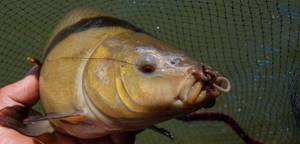
Animal baits are the most effective. Those organisms that are the usual food of the angler's potential prey every day.
One of the most effective baits for catching tench can be considered an ordinary dung worm. For one reason or another, such worms very often end up in a body of water, where they become prey for fish. In order to give the worm additional attractiveness, you can keep it in sour cottage cheese for several hours. In this case, the worm will eat the cottage cheese and begin to emit a smell that the tench really likes. He generally reacts great to cottage cheese. But more on that below!
We recommend reading: Catching rotan on the last ice
Bloodworms can be considered the next promising bait. Bloodworms also play the role of the usual food of this fish. Because bloodworms, like tench, are found in dense grassy areas. For bloodworm fishing you will need the thinnest hooks. It is better to use hooks of golden or reddish shades so that they do not stand out against the background of the bait. This will definitely have a positive impact on performance. Don't forget about maggots. Although maggots do not often become prey for tench, they strongly attract fish.
Some experienced anglers do not recognize any other baits for catching tench other than caddis. The caddisfly can be found at the bottom of the reservoir. Caddis flies live in peculiar tubular houses. Having broken such a house, you can remove the caddisfly and attach it to the hook. The so-called “sandwich” will perform well. For example, you can use caddis flies in combination with bloodworms. It’s unlikely that any tench will be able to refuse such a dish!
Plant attachments
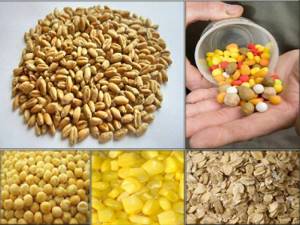
Nozzles of plant origin, frankly speaking, are somewhat inferior compared to baits of animal origin. No one wants to eat simple porridge when there is a meat dish on the table. At the same time, there are plant attachments that show decent results. What can be included here?
An ordinary bread crumb can become a bait for tench. Especially if the bread is flavored. But you should not regard the bread crumb as the main attachment. This is rather a kind of Spartan version!
But if you mix soft bread with sour cottage cheese, you get a really excellent attachment. The fact is that tench really likes sour cottage cheese. The aroma of cottage cheese attracts tench from a long distance. Its action resembles the effect of a magnet.
You can also use various grains when fishing for tench. When going for tench, take a can of canned corn with you. Surely tench will bite on such a bait. If you don’t have corn, you can replace it with peas.
You can also fish with a mastyrka. There are quite a few mastyreks on sale that are designed specifically for catching this bronze fish. But you shouldn’t follow the lead of marketers. Almost any mastyrka is suitable for catching tench, and it doesn’t matter what kind of fish is depicted on the package. Here you need to pay attention to the composition. In addition, the fisherman can not only buy a ready-made mixture, but also prepare it himself.
We recommend reading: Chub and asp, differences
In some cases, tench are also caught using boilies. A boilie is a special bait that is a ball of boiled dough. Of course, this dough contains more than just plain flour. Quite often, boilie manufacturers even keep the recipe secret. Boilies are more suitable for catching large tench using bottom tackle. A small fish simply cannot swallow a large bait.
Review of line baits
For tench, anglers have noticed seasonality in their diet. So at different times of the year it is necessary to take appropriate attachments and bait to the pond.
- In spring, fish tend to feed on various animal components, for example, snails, bloodworms, and caddis flies. During this period, dung worms work well, actively wriggling on the hook.
- After digging the earthworms, fishermen lower them into a bowl with damp moss. It has been noticed that for some reason tench react better to cleaned bait.
- Bloodworms have proven themselves well in spring fishing. However, you need to prepare for catching various small fish along the way.
- The leech is an excellent bait for large tench. By the way, you can catch these resourceful creatures with a rake when preparing the workplace. All debris removed from the bottom of the reservoir should be moved away from the shoreline. After drying, the leeches will rush to the water, then collecting them will not be difficult.
- In the spring, caddisfly larvae form houses of debris around themselves. It is noticed that the tench eats it along with the dwelling. You can collect such larvae in quiet, warm pools or small streams.
- In summer, animal baits are replaced by plant baits. To catch a decent tench, it is better to use steamed peas or canned corn.
- Pearl barley or wheat holds well on the hook. But in addition to tench, this bait attracts the attention of crucian carp and rudd.
- To catch tench in the summer, you can use various dough options, starting with the usual mixture of flour and water and ending with mastyrka, hominy and other delights.
Where to look for tench, fishing features and habits
Search for habitats
You can find tench in rivers, ponds and lakes.
- IN rivers, tench does not stand on the current; for it, shallow, low-flow areas are preferable: bays, creeks, oxbow lakes with a muddy or clay-silty bottom and abundantly overgrown with aquatic vegetation (reeds, reeds, water lilies, pondweed, horsetail, egg capsule). Also, tench does not ignore snags and places where tree crowns hang over the water. Particularly interesting are the backwaters, in which during floods the water overflows its banks and floods the nearby meadows.
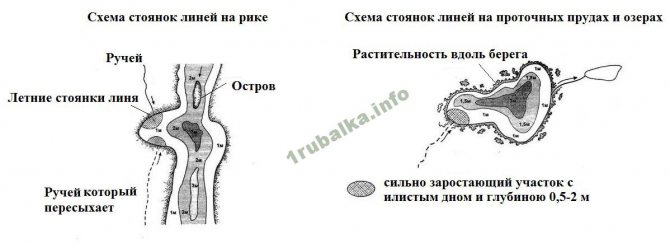
- In flowing ponds and lakes, tench choose secluded bays with dense aquatic vegetation. Moreover, the presence of even a small stream flowing into a given bay significantly increases the chances of catching tench. The same applies to river oxbows; if they lose connection with the river, then the tench here begins to degenerate from year to year. Also, cascades of ponds will be an interesting place for catching tench. If the pond is fed by underground springs, then you should look for tench near them.
- The least favorable places for catching tench with a float rod are small stagnant ponds and lakes . Here, due to the lack of sufficient oxygen, the tench gradually degenerates, and individuals no larger than the palm of your hand are caught on the hook.
When to catch tench
Fishing for tench with a float rod begins when young vegetation appears in the water. True, the best time is a few weeks before and after spawning. Tench spawns quite late, when the water warms up to 18 - 20 degrees Celsius; according to the time of year, this is the end of May, the beginning of June. In July, due to the strong growth of aquatic vegetation, catching tench with a float becomes much more difficult, and in some places, without preparing the site yourself, it is completely impossible. Fishermen, on the eve of fishing, clear the future fishing area of algae in advance with a rake. You can actively catch tench until September, then due to the cooling and wilting of aquatic vegetation, the chances of catching it become less, although there have been cases of catching tench even in late autumn.
They catch tench in the morning from sunrise until 8 am. In the evening, two to three hours before sunset, and you can catch it at night, but during the day it doesn’t like to peck.
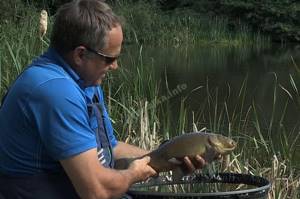
Line fishing is not an active type of fishing; sometimes you can expect a bite for about an hour, and sometimes you will only see two or three bites during the entire fishing period. But tench is such a rare trophy that catching 4-5 bronze beauties will greatly raise your authority among other fishermen, and you will get great pleasure from defeating a smart and strong opponent; it is not for nothing that it is easier to catch a one and a half kilogram carp than a 600 gram tench.
Features of catching tench with a float rod
Tench are caught either at the edge of aquatic vegetation or in its windows. In some promising areas, you can only catch tench by wading or from a boat.
In general, the uniqueness of tench lies in the fact that it chooses rather shallow areas, 1-2 meters deep, and sometimes it can be found even at a depth of 40-60 cm.
If you notice how the reeds open and close, it means that a tench has passed through, sometimes it can be a large crucian carp, but mostly tench. Also, tench can produce bubbles under water.
Unfortunately, tench is not a schooling fish; you can rarely find groups of two to five individuals; they often stay alone, so catching tench with a float rod is quite passive and requires maximum patience from the angler. Tench also does not like noise, which can easily scare it away.

The bite of tench deserves special attention; unlike other fish, it is not sharp and confident, so you should not hook it immediately as soon as the float moves. Tench likes to take the bait slowly, tasting it and sucking it. Often, having taken the bait into its mouth, the tench immediately spits it out, then carefully swallows it again, slowly dissolving it. Such a game with bait can last 1-2 minutes, although sometimes it lasts longer. If your gear is too rough, the tench can gently eat your bait without you even noticing. Although a hungry tench attacks the bait clearly and confidently.
After hooking, the tench will immediately try to hide in the thickets of algae or reeds, so you should not give it any slack, otherwise it will be difficult to get it out of there.
Even for small lines, use a landing net; it should have a long handle, since in the line areas, under the shore, there is a lot of algae, pulling through which you will most likely break the equipment.
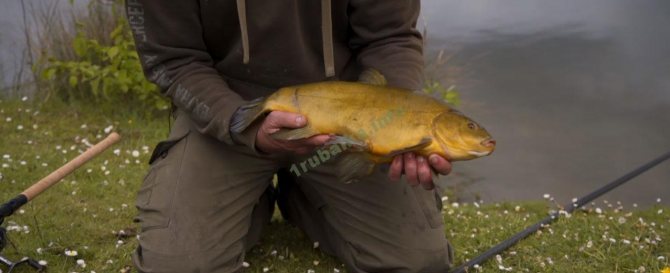
Hooks
The hook is, of course, the most important element of the equipment.
Regardless of the size of the intended fish, the hook must meet the following requirements:
- Be sharp enough and hardened so that when tested on the nail the hook will scratch it;
- Be proportionate to the size of the tench and match the bait.
The success of fishing significantly depends on the quality of the hook, how sharp, durable, tenacious, unnoticeable and elastic it is.
Hooks differ in thickness, width, bend shape and length. Hooks can be single, double, triple. When fishing for tench, single models are chosen.
Single hooks are divided into single-bend (the tip is bent in the same plane as the fore-end) and double-bend (the fore-end and the tip are bent in different planes).
The head of the hook can be in the form of a ring or blade, located in the plane of the fore-end, or curved inward or outward - towards the tip.
The ring on the hook often does not fit into the shank, creating a gap with sharp wire edges. They often break the line at the most unnecessary moment. Some fishermen solder the slit or wrap thread around it. There is another way to prevent breakages. Light a candle and take the hook by the bend, heat the ring a little over the fire and immediately bring part of the vein to the crack. It melts and securely seals the gap. After this operation, unexpected line breaks will end.
Many professional fishermen claim that ring hooks are easier to tie . But the ring is more visible than the shoulder blade. But when fishing for tench, sometimes the fishing line comes off the shoulder blade. To prevent such a design flaw, the assembly is treated with moisture-resistant glue.
A high-quality hook should bend when pressed at the mouth, and break when bending the tip to the side. But at first it bends slightly, becomes deformed, and then, with subsequent overload, breaks. If it simply breaks, then it is overheated; if it only bends, it is not overheated.
The reliability of the hook is increased to a certain extent by flattening the hook - this hook is called forged. But small forged hooks cut the lip of a tench relatively easily.
The transverse hook is not round, but I-beam, it would be much more reliable, and it would not cut the line’s lip as much. The I-beam shape is best only for the forehead and back of the hook. The ring and fore-end are better rounded - in this case they do not cut the line so much. A small ring is better than a spatula. The shoulder blade is often either narrow or sharp. It is best for the fore-end to be slightly thinner than the forehead and back of the hook, which bear the main load.
The shape of the curve of the forehead of the hook is important. A straight bend is better, as it makes it easier for the hook to set. The slightly protruding forehead of the hook will hold the line more reliably, as it captures a large area of tissue in the fish’s mouth.
The beard should not be very thick - the thicker the beard, the weaker the forehead of the hook. The greater the angle of the beard towards the forehead, the better it prevents the line from coming off, but hooking becomes more difficult, and often the wound on the lip increases. Therefore, moderate thickness and average extension of the beard are best.
Anti-corrosion hooks:
- nickel plated;
- galvanized;
- oxidize;
- varnish;
- bronzed.
Guide to fishing
- To begin, choose a place and try feeding with small portions of chopped worms, maggots and corn. If the line is on the point, it will quickly come straight to your place.
- If the tench does not bite, you can send the main portion of bait to a given place; it is important to feed very precisely.
- When casting, do not splash the float equipment on the water, but lay it down smoothly, thereby you will not scare away the already timid tench.
